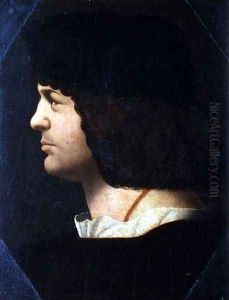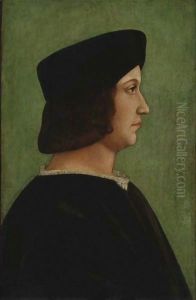Bernardino de' Conti Paintings
Bernardino de' Conti was an Italian painter who is considered part of the Lombard school, active during the Renaissance period in Northern Italy. He was born around 1460, although the exact date and place of his birth are not well documented. His work is often associated with the city of Pavia, where he was active for a significant part of his career.
De' Conti's style was influenced by Northern European art as well as by the work of Leonardo da Vinci, who was operating in Milan at the time. Although Bernardino de' Conti's work is not as widely known as some of his contemporaries, he made a notable contribution to the art of his period, particularly in the Lombard region.
One of his most recognized works is the ‘Virgin and Child’, which is housed in the National Gallery in London. This painting reflects the tender interaction between the Virgin Mary and the Christ Child, and it is characterized by its delicate coloring and refined execution, which shows the influence of Leonardo. Another significant work attributed to him is the ‘Portrait of a Youth’, which is part of the collection in the Pinacoteca di Brera in Milan.
Throughout his career, Bernardino de' Conti produced a number of religious works, including altarpieces and devotional paintings. His paintings often feature serene figures and display a mastery of chiaroscuro and a careful attention to detail. Not much is known about his training or early life, but it is evident from his works that he was deeply embedded in the artistic milieu of Lombardy and was significantly influenced by the artists in Milan.
De' Conti's date of death is recorded as 1525, and by the time of his death, he had established himself as a respected artist in Northern Italy. His legacy is preserved in the paintings that survive him, which continue to be studied for their contribution to the understanding of the Lombard school of painting during the Italian Renaissance. Although Bernardino de' Conti may not have achieved the same level of fame as some of his peers, his work remains an important piece of the rich tapestry of Renaissance art.

